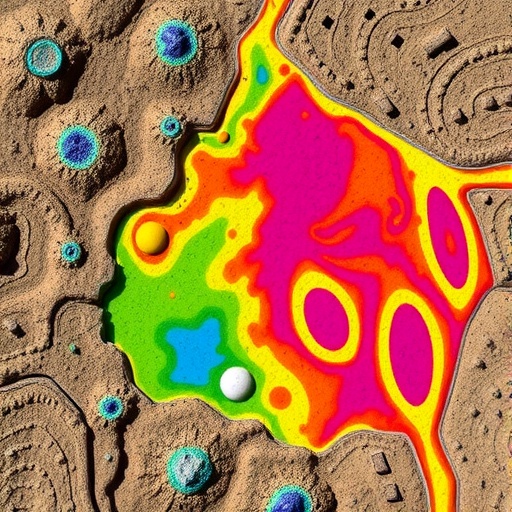In a groundbreaking advancement for environmental science and agricultural management, a new study unveils a sophisticated approach to accurately map and analyze soil moisture and salinity using integrated remote sensing data combined with the OPTRAM model. This innovative framework promises to revolutionize the way soil properties are monitored on a large scale, offering unprecedented precision and granularity essential for sustainable land use and water resource management.
Soil moisture and salinity are critical parameters influencing agricultural productivity, ecosystem health, and hydrological cycles. Traditional in-situ measurements are often labor-intensive, spatially limited, and incapable of providing continuous monitoring over extensive areas. Recognizing these challenges, researchers have sought to leverage remotely sensed data from satellites in conjunction with advanced modeling techniques to fill the knowledge gap and deliver more actionable insights.
The recent study, conducted by a team led by Soumaia, M., Asma, E.A., and Basma, L., integrates radar backscatter and optical imagery within the framework of OPTRAM—a physically based semi-empirical model designed to estimate soil moisture by analyzing changes in surface reflectance and roughness. By incorporating soil salinity into this model, the researchers have expanded its utility, enabling simultaneous assessment of two vital soil parameters that often co-vary but are difficult to distinguish from remote sensing data alone.
At the core of the OPTRAM model lies the concept of separating soil moisture effects from other confounding factors such as surface roughness, vegetation cover, and in this instance, the saline content that influences dielectric properties of the soil. This separation is vital because salinity alters the soil’s electrical conductivity, thereby affecting radar backscatter signals differently from moisture content. The research team’s innovation was to adapt the algorithm to disaggregate these complex signals, yielding distinct retrievals for moisture and salinity.
The practical applications of this study are extensive. For instance, soil salinity is a major constraint to agricultural productivity, especially in arid and semi-arid regions where irrigation practices can exacerbate salt accumulation. Early detection and monitoring enable land managers to implement corrective measures before salinity reaches levels harmful to crops. The advent of accurate remote sensing-based salinity mapping therefore holds great promise for sustainable agriculture.
Moreover, reliable soil moisture information enhances weather prediction models, irrigation scheduling, and drought assessment. The fine-scale disaggregation achieved by integrating OPTRAM with satellite data creates spatial datasets valuable for hydrologists and meteorologists alike. It also supports climate change research by providing insights into how soil water availability and salinity patterns evolve under shifting precipitation regimes.
The study leveraged multiple remote sensing platforms, exploiting the synergistic advantages of radar and optical sensors. Radar data is especially valuable due to its sensitivity to soil moisture and ability to penetrate cloud cover, unlike optical sensors which can be limited by atmospheric conditions but provide complementary spectral information related to vegetation and soil properties. By fusing these datasets, the researchers could compensate for limitations inherent to each sensor type.
In their experimental setup, the team applied the integrated approach over diverse testing sites characterized by varying soil textures, moisture regimes, and salinity levels. Calibration and validation efforts included both ground-truthing measurements and comparative analysis against existing soil databases. The results demonstrated robust correlation coefficients between modeled and observed values, confirming the model’s accuracy and versatility.
Technically, the methodology involved preprocessing steps such as co-registration of satellite images, speckle filtering for radar data, and normalization of optical reflectance. The OPTRAM model parameters were calibrated using a combination of theoretical dielectric mixing models and empirical relationships derived from field measurements. A key outcome was the model’s ability to differentiate areas affected primarily by moisture changes from those influenced by salinity variations, as evidenced by spatially coherent and physically consistent maps.
Beyond environmental monitoring, the findings have implications for disaster management. Soil salinization and moisture deficits often precede land degradation and desertification processes, which threaten food security and livelihoods in vulnerable regions. The capability to promptly identify these precursors can inform policy decisions, land rehabilitation efforts, and allocation of resources to mitigate adverse impacts.
This research also sets the stage for further technological advances. The approach can be adapted to upcoming satellite missions with higher resolution and more frequent revisit times, enhancing temporal and spatial fidelity. Additionally, machine learning techniques could be integrated with OPTRAM outputs to improve predictive accuracy and automate large-scale soil condition assessments.
Despite its achievements, the study acknowledges challenges such as the influence of surface vegetation dynamics, terrain variability, and atmospheric effects which, although partially addressed, still require refinement in the modeling process. Future work may focus on refining parameterization schemes and exploring multisource data fusion strategies to enhance robustness under diverse environmental conditions.
In essence, the integrated remote sensing and OPTRAM model methodology represents a paradigm shift in soil moisture and salinity monitoring. It overcomes previous limitations by providing disaggregated, spatially explicit data critical for ecological modeling, precision agriculture, and natural resource management. The wide-ranging benefits underscore its potential to become a standard tool in environmental Earth sciences.
As global climate patterns continue to challenge traditional agricultural and environmental systems, the demand for reliable, scalable soil monitoring solutions grows ever more urgent. Innovations such as the OPTRAM integration described in this study bring us closer to that goal, enabling scientists, farmers, and policymakers to make informed decisions grounded in high-quality data.
Ultimately, this work exemplifies the transformative power of combining physics-based models with cutting-edge remote sensing technologies. By unraveling the complex interplay between soil moisture and salinity, it enriches our understanding of terrestrial processes and enhances our capacity to manage the planet’s precious land resources sustainably and effectively.
Subject of Research: Soil moisture and salinity monitoring through remote sensing data integration with the OPTRAM model.
Article Title: Soil moisture and salinity disaggregation by integrating remote sensing data with the OPTRAM model.
Article References:
Soumaia, M., Asma, E.A., Basma, L. et al. Soil moisture and salinity disaggregation by integrating remote sensing data with the OPTRAM model. Environ Earth Sci 84, 465 (2025). https://doi.org/10.1007/s12665-025-12453-4
Image Credits: AI Generated




